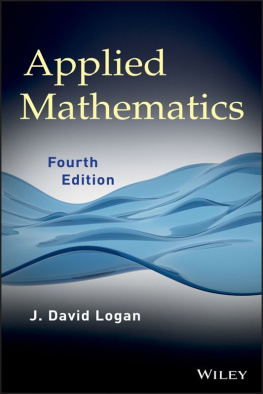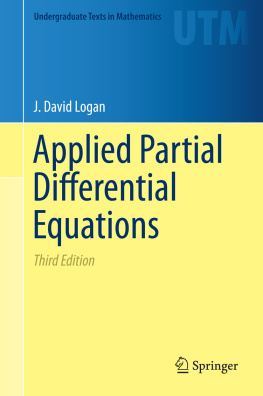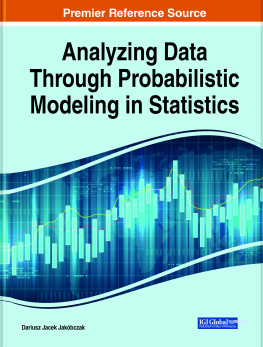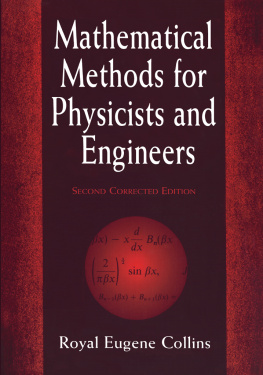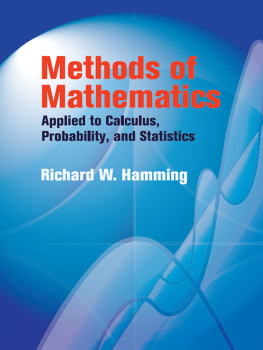Contents
Applied Mathematics
Copyright 2013 by John Wiley & Sons, Inc. All rights reserved.
Published by John Wiley & Sons, Inc., Hoboken, New Jersey.
Published simultaneously in Canada.
No part of this publication may be reproduced, stored in a retrieval system or transmitted in any form or by any means, electronic, mechanical, photocopying, recording, scanning or otherwise, except as permitted under Section 107 or 108 of the 1976 United States Copyright Act, without either the prior written permission of the Publisher, or authorization through payment of the appropriate per-copy fee to the Copyright Clearance Center, Inc., 222 Rosewood Drive, Danvers, MA 01923, (978) 750-8400, fax (978) 750-4470, or on the web at www.copyright.com . Requests to the Publisher for permission should be addressed to the Permissions Department, John Wiley & Sons, Inc., 111 River Street, Hoboken, NJ 07030, (201) 748-6011, fax (201) 748-6008, or online at http://www.wiley.com/go/permission .
Limit of Liability/Disclaimer of Warranty: While the publisher and author have used their best efforts in preparing this book, they make no representation or warranties with respect to the accuracy or completeness of the contents of this book and specifically disclaim any implied warranties of merchantability or fitness for a particular purpose. No warranty may be created or extended by sales representatives or written sales materials. The advice and strategies contained herein may not be suitable for your situation. You should consult with a professional where appropriate. Neither the publisher nor author shall be liable for any loss of profit or any other commercial damages, including but not limited to special, incidental, consequential, or other damages.
For general information on our other products and services please contact our Customer Care Department within the United States at (800) 762-2974, outside the United States at (317) 572-3993 or fax (317) 572-4002.
Wiley also publishes its books in a variety of electronic formats. Some content that appears in print, however, may not be available in electronic formats. For more information about Wiley products, visit our web site at www.wiley.com .
Library of Congress Cataloging-in-Publication Data:
Logan, J. David (John David)
Applied mathematics / J. David Logan. 4th ed.
pages cm
Includes bibliographical references and index.
ISBN 978-1-118-47580-5 (hardback) ISBN 978-1-118-51492-4 ISBN 978-1-118-51493-1 ISBN 978-1-118-51490-0 1. MathematicsTextbooks. I. Title.
QA37.3.L64 2013
510dc23
2013001305
To my parents
George Edd Logan (19191996)
Dorothy Elizabeth Wyatt Logan (19232009)
Preface
The fourth edition of Applied Mathematics shares the same goals, philosophy, and style as its predecessorsto introduce key ideas about mathematical methods and modeling, along with the important tools, to mature seniors and graduate students in mathematics, science, and engineering. The emphasis is on how mathematics interrelates with the applied and natural sciences. Prerequisites include a good command of concepts and techniques of calculus, and sophomore-level courses in differential equations and matrices; a genuine interest in applications in some area of science or engineering is a must.
Readers should understand the limited scope of this text. Being a broad introduction to the methods of applied mathematics, it cannot cover every topic in depth. Indeed, each chapter could be expanded into a one, or even several, full-length books. In fact, readers can find elementary books on all of the topics; some of these are cited in the references at the end of the chapters. Secondly, readers should understand the mathematical level of the text. Some books on applied mathematics take a highly practical approach and ignore technical mathematical issues completely, while others take a purely theoretical approach; both of these approaches are valuable and part of the overall body of applied mathematics. Here, we seek a middle ground by providing the physical basis and motivation for the ideas and methods, and we also give a glimpse of deeper mathematical ideas.
There are major changes in the fourth edition. The material has been rearranged and basically divided into two parts. Chapters 1 through 5 involve models leading to ordinary differential equations and integral equations, while Chapters 6 through 8 focus on partial differential equations and their applications. Motivated by problems in the biological sciences where quantitative methods are becoming central, Chapter 9 deals with discrete-time models, which include some material on random processes. Sections reviewing elementary methods for solving systems of ordinary differential equations have been added in Chapters 1 and 2. Many additional examples and figures are included in this edition, and several new exercises appear throughout. Some exercises from the last edition have been revised for better clarity, and many new exercises are included. The length of the text has expanded over 160 pages. The Table of Contents details the specific topics covered.
Note that equations are numbered within sections. Thus, equation label (3.2) refers to the second numbered equation in Section 3 of the current chapter.
My colleagues in Lincoln, who have often used the text in our core sequence in applied mathematics, deserve special thanks. Glenn Ledder, Richard Rebarber, and Tom Shores have provided me with an extensive errata, and they supplied several exercises from graduate qualifying examinations, homework, and course exams. Former students Bill Wolesensky and Kevin TeBeest read parts of the earlier manuscripts and both were often a sounding board for suggestions. I am extremely humbled and grateful to those who used earlier editions of the book and helped establish it as one of the basic textbooks in the area; many have generously given me corrections and suggestions, and many of the typographical errors from the third edition have been resolved. Because of the extensive revision, some new ones, but hopefully not many, have no doubt appeared. I welcome suggestions, comments, and corrections, and contact information is on the books website: http://www.unl.edu/~jlogan1/applied-math.htm . Solutions to some of the exercises and an errata will appear when they become available.
My editor at Wiley, Susanne Steitz-Filler, along with Jackie Palmieri, deserves praise for her continued enthusiasm about this new revision and her skill in making it an efficient, painless process. Finally, my wife, Tess, has been a constant source of support for my research, teaching, and writing, and I again take this opportunity to publicly express my appreciation for her encouragement and affection.
Suggestions for use of the text. The full text cannot be covered in a two-semester, 3-credit course, but there is a lot of flexibility built into the text. There is significant independence among chapters, enabling instructors to design special one- or two-semester courses in applied mathematics that meet their specific needs.
Portions of Chapters 1 through 5 can form the basis of a one-semester course involving differential and integral equations and the basic core of applied mathematics. Chapter 4 on the calculus of variations is essentially independent from the others, so it need not be covered. If students have a strong background in differential equations, then only small portions of Chapters 1 and 2 need to be covered.
A second semester, focused around partial differential equations, could cover Chapters 6,7, and 8. Students have the flexibility to take the second semester, as is often done at the University of Nebraska, without having the first, provided small portions of Chapter 5 on Fourier-type expansions is covered.
Next page
